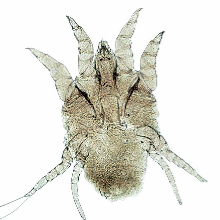-
Arlan, L.G et al (1981) Infestivity of Psoroptes cuniculi in rabbits, American Journal of Veterinary Research, 42: 1782-1784 Curtis, S.K et al (1990) Use of ivermectin for treatment of ear mite infestation in rabbits, Journal of the American Veterinary Medical Association, 196 (7): 1139-1140
-
Harcourt-Brown, F.M (2002) Textbook of Rabbit Medicine and Surgery, Butterworth-Heinemann, Oxford Jenkins, J.R (2001) Skin disorders of the rabbit, Veterinary Clinics of North America: Exotic Animal Practice, 4: 543-563 Kurade, N.P, Bhat, T.K and Jithendran, K.P (1996) Effect of ivermectin against ear mange mite (Psoroptes cuniculi) in naturally infested rabbits, World Rabbit Science 4: 25-27
-
Meredith, A (2006) In: Paterson, S. (Ed.) Skin Diseases of Exotic Pets, Blackwell Publishing. Chapters 14-24; 175-324 Scarff, D. (2008) Skin diseases of pet rabbits, UK Vet 13 (2): 66-75
-
Scott, D.W, Miller,W.H and Griffin, C.E (2001) Dermatoses of pet rodents, rabbits and ferrets In: Muller and Kirk’s Small Animal Dermatology. Chapter 21
Ear Mites in Rabbits
By Jenna Richardson BVM&S MRCVS,
Rabbit, Exotic Animal and Wildlife Clinician at Royal (Dick) School of Veterinary Studies
Frequently Asked Questions:

What is the name of the ear mite seen in rabbits?
Psoroptes cuniculi is the rabbit ear mite.
How are the mites identifiable?
Mites are relatively large and oval-shaped. They have moderately short legs, with long segmented suckers attached distally.
What is the lifecycle of ear mites?
The lifecycle is approximately 21 days, with adult females laying eggs in the wax and debris of the ear canal. After four days, eggs hatch into larvae, becoming adults after a couple of moults.
How are ear mites transmitted?
Mites are transmitted by direct contact between infected rabbits and via infected fomites.
What symptoms are associated with ear mite infections?
Ear mites cause otitis externa in rabbits and are very irritating to the ear canal lining due to antigenic material in their faeces and saliva. This results in pruritis, often to a severe degree.
Clinically affected rabbits can become head-shy and owners may notice a subdued demeanour. Observations of ear scratching with the hind feet are noted along with head shaking.
Ear canals can become congested with a thick crusting exudate also referred to as ‘ear canker’. In severe cases, lesions can spread to the face, neck, abdomen and forelimbs.
What are the differential diagnosis?
Other conditions that can cause scabbing and exudate in the ear canals include the spirochaete Treponema cuniculi and bacterial or mycotic otitis externa.
How can I confirm a diagnosis?
The mite can be visualised on otoscopic examination of the ear. For confirmation, debris from the ear can be carefully collected and mineral oil added prior to visualisation under microscopic examination.
How do I treat the mites?
The mites can be treated with a variety of different anti-parasite treatments including a topical ivermectin Spot-on, such as Xeno® 450 Spot-on or Xeno® 50 mini Spot-on applied to the back of the neck.
Ear mites can cause irritation and pain. It is advisable to use a non-steroidal anti-inflammatory drug as part of the treatment protocol.
Avoid removal of crusts as this can be very painful, resulting in open ulcerated sites. Instead crusts can be softened with mineral oil and allowed to fall off naturally.
Claws on the hind feet can be trimmed to reduce damage inflicted through self-trauma in response to pruritis.
What happens if I don’t treat an ear mite infection?
If not treated, an ear mite infection can become very debilitating for the affected animal. Weight loss, gut stasis and secondary bacterial infections of the ears are possible. Otitis externa can progress to otitis media or interna, with rupture of the tympanic membrane and the development of vestibular and other neurological signs.
Prompt treatment of an ear mite infection is strongly advised.
Can rabbit ear mites infect other species?
Rabbit ear mites are generally species specific, however there has been one reported case of disease in a guinea pig.
How do I prevent re-infection?
Mites are able to survive off the host and can live within the environment on debris for 21 days. If an ear mite infection is confirmed, full decontamination of the enclosure is necessary. Treatment of the rabbit should extend to cover a period exceeding 21 days. For example, the recommended ivermectin protocol is one treatment topically, for example Xeno® 450 Spot-on or Xeno mini Spot-on ( use the correct size of product for the weight of the animal), every 14 days for three applications.
Any new rabbits entering a group or household should have a thorough clinical examination to ensure they are parasite free.
Is regular ear cleaning in rabbits necessary?
In normal healthy rabbits, routine ear cleaning is not indicated. With individuals prone to wax build up, careful cleaning of the ear canal may be warranted. Lop-eared breeds appear more prone to the build up of wax and debris.
References and Further Reading add
